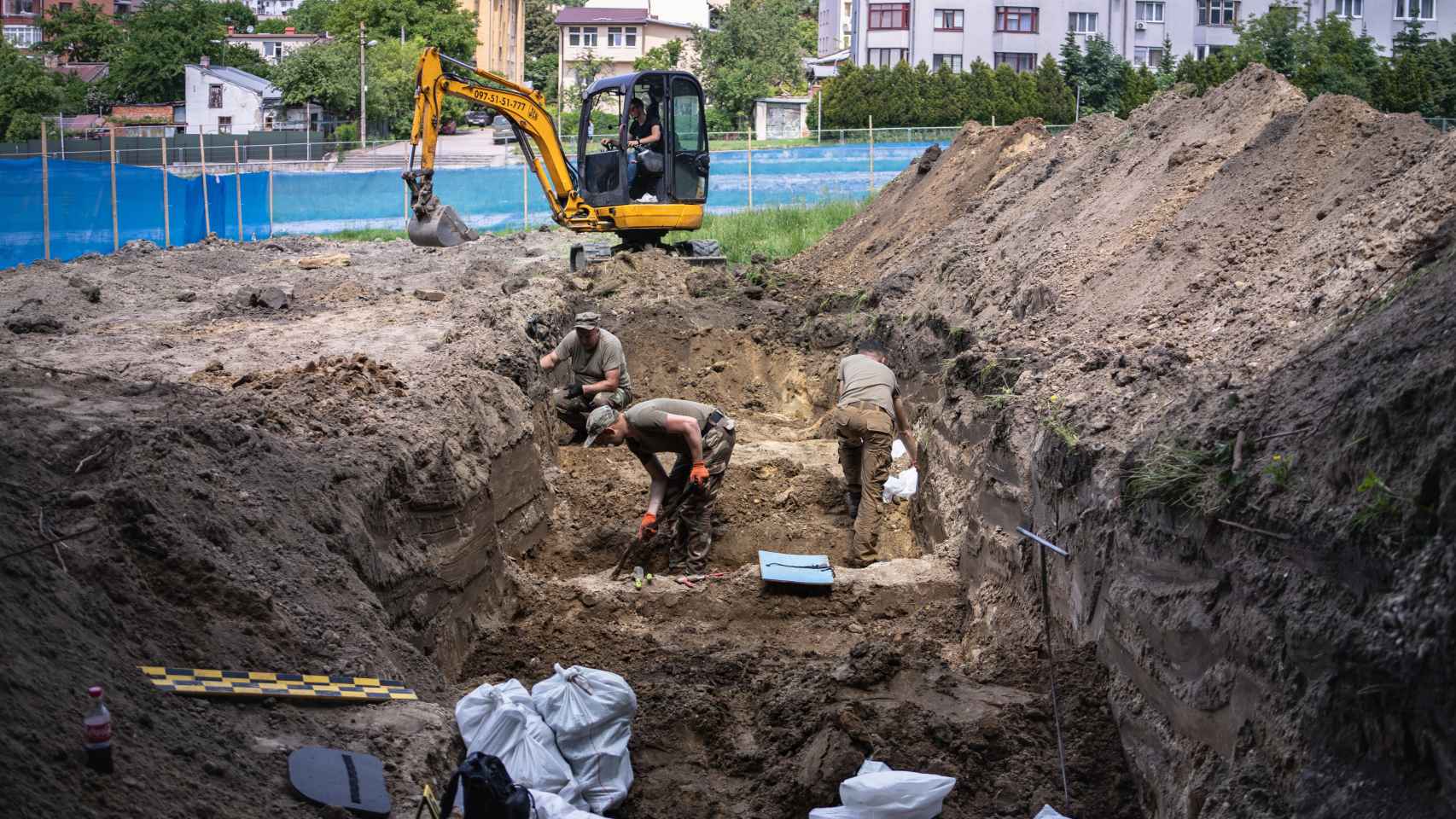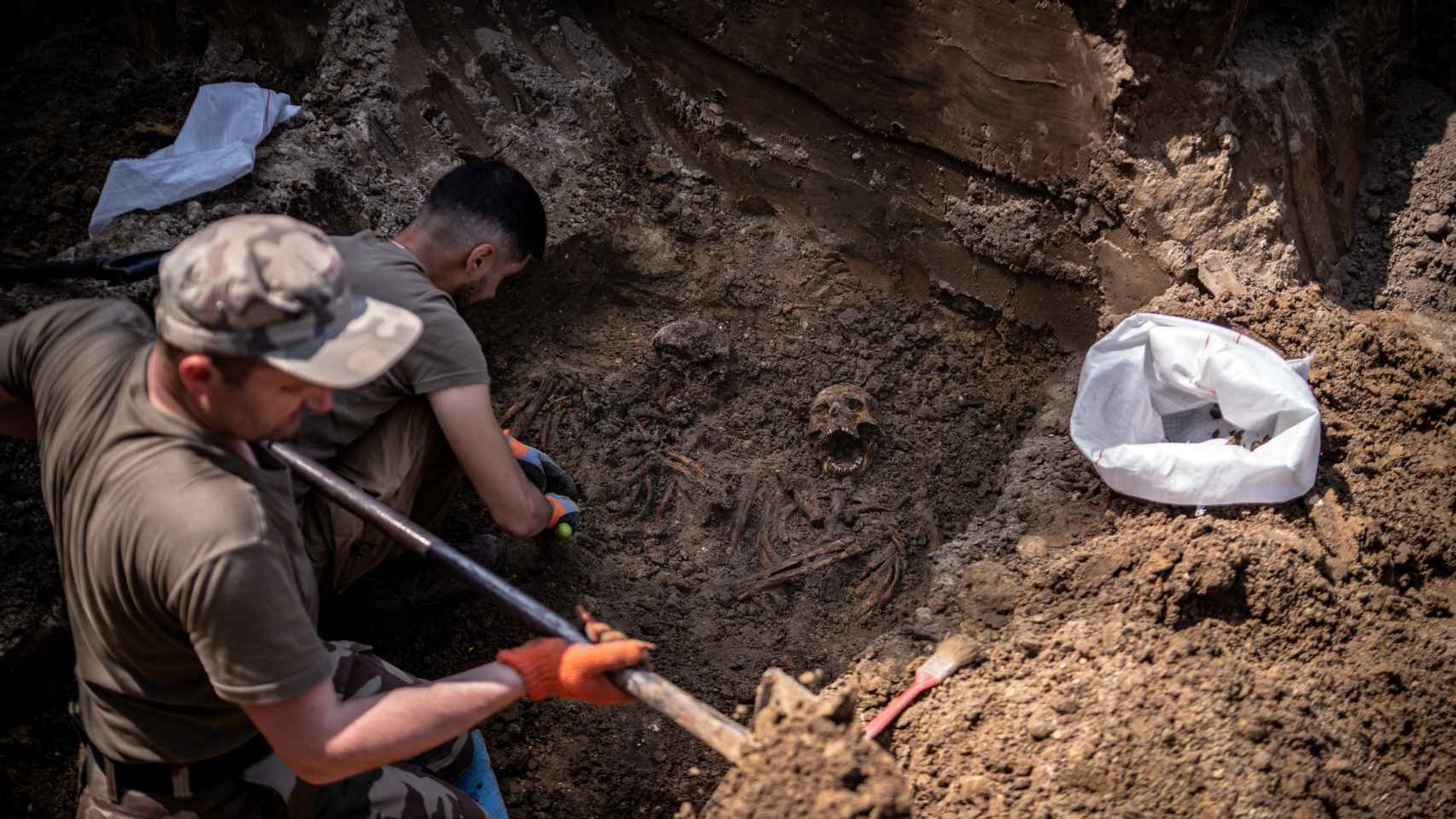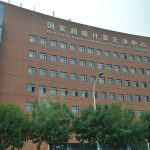At 60 years old, Volodymyr Kharchuk it’s strong enough to dig eight hours without a break exhuming corpses under the sun, but not to cry in front of a journalist. That’s why she looks away and is silent as she listens to the trumpets and drums that announce the death of a new hero in the city.
Fifty meters separate his workplace from Oleksandr’s farewell. As Kharchuk shovels up dirt, the late Ukrainian soldier they bury him with her. It is the other side of a conflict that knocks on the rear door every day to remind families that their children, parents and grandchildren they keep dying on the front line of combat.
As EL ESPAÑOL has been able to document, only In the city of Lviv, 429 soldiers have died in 464 days of war. Many for a population that had 720,000 inhabitants before the invasion. Too many for a cemetery in which the military dead no longer fit. Igor Fedorchyk’s burial in March last year was one of the last to take place inside the Lychakiv cemetery before authorities began work on land on the other side of the wall.

An excavator supports the work of Kharchuk’s men, until they find new remains. So, she begins the effort with small brushes and shovels so as not to break the bones.
But this one is also filling up. So the City Council decided to make the upper part of the hill suitable for future casualties, anticipating a counteroffensive that could multiply Ukrainian casualties. The surprise: the discovery of more than 200 corpses buried in a common grave. Not even here, they say in Lviv, do the Russians leave them alone.
“These guys didn’t want to go to war, but the war has come to our country and they have been forced to die,” snorts Kharchuk, an archaeologist and assistant chief of the Dolya Memorial and Search Center, as he looks at some of the most recent graves. “These, on the other hand,” he says, pointing to the graves in which they have been working since this March, They were occupiers during World War II. They came to kill us and our women.”
[La OTAN se divide por los riesgos de la adhesión de Ucrania: “Entraríamos en guerra con Rusia”]
He expresses it with the pain of a man tired of seeing how your country bleeds and with the knowledge of what their work entails. In Dolya they are in charge of investigating, exhuming and reburying people who have died as a result of deportations, political repression and conflicts. This is well known in the Ukrainian West.
In the last century, Lviv has suffered from the Russian occupation during the First World War; the Polish-Ukrainian war, at the end of the previous conflict; Nazi invasion and Soviet occupation which ended with the region integrated into the USSR. Precisely in that decade, in the 40s, was born the Ukrainian Insurgent Army (UPA) –linked to the Organization of Ukrainian Nationalists (OUN) led by Stepan Bandera-, which fought against Germans, Poles and Russians.

The meticulous work ends with the extraction of the bodies, and their subsequent custody inside bags that still have no destination.
Lviv
Its red and black banner now flies to all corners of the country, including many of the graves in which Ukrainians who sacrificed their lives in the defense of a land that Vladimir Putin still dreams of conquering.
A little higher, just a few meters from the graves, the exhumation of remains continues. They are, for the most part, bones and skulls of agents of repression.
[Así era el Yuri Olefirenko, el último buque de guerra de Ucrania que acaba de destruir Rusia]
“Between 1946 and 1947, the Soviets established a cemetery at this location for soldiers killed in World War II and NKVD (secret police, germ of the KGB) troops who died during operations against the civilian population and in battles with the Ukrainian Insurgent Army,” explains Lilya Onyshchenkoadvisor to the mayor of Lviv for the conservation of cultural heritage.
“They did the same thing that their grandchildren do now. The same torture, the same crimes… So are the Russians. They have not changed“Kharchuk says with a cracking voice.

The NKVD murdered thousands of prison inmates in western Ukraine. Their methods: rapid execution with a firearm, bayoneting while they slept or burning them alive.
Lviv
He has not lost any relatives since the start of the invasion, although he has lost several friends, and he would not like to see them buried together under the same ground: “This is important work because they are more and more (the fallen in the current war), and we don’t want to mix them“.
A complicated debate introduced by the archaeologist and doctor of History Mykola Bandrivskii. According to him, it could be accepted that the Ukrainian military be buried in the Lychakiv cemetery, where thousands of USSR soldiers and officers share space with members of the Ukrainian Armed Forces. However, he explained in May 2022, “if Ukrainian heroes continue to be buried here, sooner or later their graves will be very close to the Soviet ones. Is this good or bad? I honestly don’t know.”
lies and crimes
The problem comes from a Russian lie, since in 1974 the Soviet authorities announced the transfer of NKVD bodies to a memorial in another location. However, the tombstones recovered by the excavation of this 2023 confirm that only they buried everything with more earth.
Of the hundreds of corpses found, a small number belong to the Austro-Hungarian Empire casualties in the Great War. The rest formed part of the body of communist repression. A past that complicates their future, because the former will be relocated to the sections of the cemetery corresponding to their time. The fate of the Soviets “is still unknown,” sources from the Consistory explain.
[El presidente de Bielorrusia ofrece “armas nucleares para todos” los países que se unan a Putin]
“We treated them humanely because they were human and maybe not all of them wanted to kill us. They were just following orders“, confesses Kharchuk, while three of his companions delicately clean the bones they found today with small brushes.
— Could it be possible that some of them were grandparents of the grandchildren who are now buried here?
“In theory… p-could be, but I doubt it…” Kharchuk stammers before correcting himself. No, it is not possible. These people were not local, they came to our land. The soldiers who die now are grandchildren of the rebels who tried to prevent the Soviet dictatorship.
It is the first time in the conversation that his tone falters and that the translation fills in the silences in his response. A denial more based on faith than on certainty and which forgets that, according to different estimates, Lviv lost between 70 and 80% of its autochthonous population between 1939 and 1946.
A hope with which to ward off the crimes that some they committed in life and that still pay underground today.












